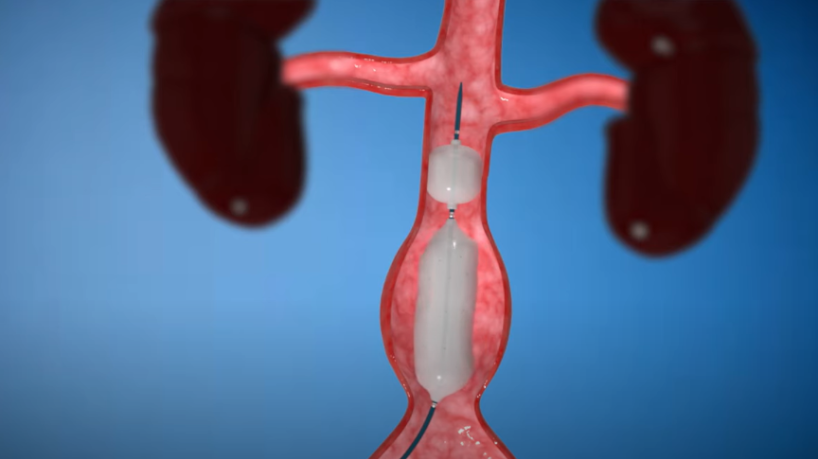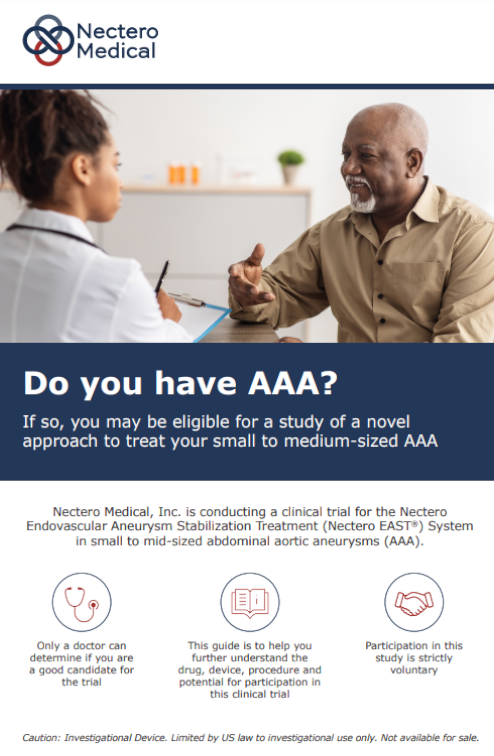What is AAA
The aorta is the largest blood vessel in the body, carrying blood away from the heart to the rest of the body. The abdominal aorta is the portion located in the abdomen or stomach area. The normal width of the aorta is approximately 2 centimeters (cm), similar to a garden hose.
Due to age, genetic conditions, disease or trauma, the wall of the aorta can become weak. This weakening can cause the aortic wall to bulge or stretch, which can cause the aortic wall to weaken further. This is called an aortic aneurysm.

Healthy abdominal aorta

Abdominal aorta with aneurysm
AAA is an acronym for Abdominal Aortic Aneurysm. It is a bulging, stretching, or ballooning of a weakened area of the wall of the abdominal aorta. As it grows, the aneurysm can rupture or burst, leading to massive internal bleeding. A ruptured aortic aneurysm can cause death and requires immediate medical attention.

Current treatment options in the U.S.
Treatment options for AAA are based on the aneurysm size and status.
- Larger aneurysms (larger than 5.5cm for med or larger than 5.0cm for women) are treated with endovascular repair (EVAR) or surgery
- If a patient has a small to mid-sized AAA, there is no currently proven treatment
- Any AAA that is 3.5 to 5.0cm (for men) or 3.5 to 4.5cm (for women) is considered small to mid-sized
- Physicians will place the patient under surveillance, or “watch and wait” to track the size and growth of the aneurysm
- Physicians may monitor and measure the AAA with regular ultrasound or computed tomography angiography (CTA) scans
Nectero EAST® System
The Nectero Endovascular Aneurysm Stabilization Treatment (Nectero EAST®) System is being studied as a potential novel treatment to stabilize growth and potentially prevent rupture of small to mid-sized abdominal aortic aneurysms (AAA). The system uses a catheter to deliver a liquid compound with a proprietary molecule, referred to as a stabilizer agent, directly to the site of the aneurysm. The minimally invasive procedure takes about 1 hour, and patients may need to lay flat for four to six hours immediately following the procedure.
The goal for this new technology is to allow earlier intervention or treatment, instead of watching and waiting. If successful, the treatment may potentially:
- Prevent further weakening of the aneurysm
- Strengthen the aortic tissue around the aneurysm
- Prevent or significantly delay the need for major endovascular repair (EVAR) or open surgical repair
stAAAble Trial
The decision to participate in clinical trial research requires careful consideration by you and your family. Your physician is the best person to help you decide if a clinical trial or any other treatment option is right for you.
We are conducting a clinical trial to further validate the safety and efficacy of the Nectero EAST® System
- The stAAAble Trial will include up to 400 patients in as many as 50 locations
- Participating physicians will determine which patients are appropriate for the study
Study participants may or may not receive treatment with the Nectero EAST® System
- Patients will be randomly assigned to one of two groups
- One group will be treated with the Nectero EAST® System
- One group will be managed traditionally with surveillance (“watching and waiting”)
All patients will have follow-up visits with their physician that include evaluation of their AAA size using CT (computed tomography) with appointments at 30/60 days, 6, 12, 18, 24, 48, and 60 months
- Clinical experts will review and report results after all 24-month appointments have been completed
- Longer term follow-up provides further important information on safety and efficacy
- All study participants may benefit from the ongoing aneurysm observation throughout the study period
For more information, please contact your physician or go to https://clinicaltrials.gov/study/NCT06001918.

